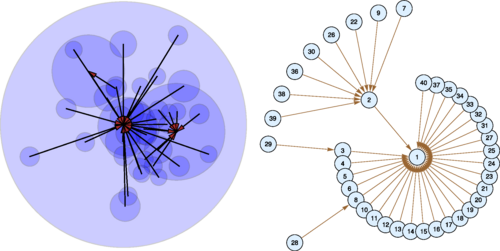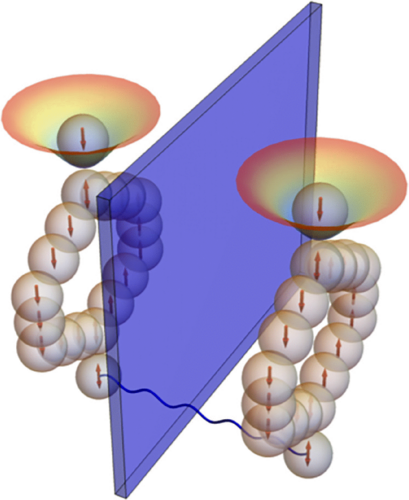| Volume 108, Issues 11 - 12 December 2023 | | Advertisement | Abstract submissions for APS April Meeting 2024 close Friday, January 5! Gather your groundbreaking research, spanning Quarks to Cosmos, to share with the best and brightest in academia, industry, and national labs. Remember, you must be an APS member to submit. Learn more about the abstract submission process. | | | | |
Advertisement  | Instant extraction of nonperturbative tripartite entanglement
Diana Méndez Avalos, Kensuke Gallock-Yoshimura, Laura J. Henderson, and Robert B. Mann
Phys. Rev. Research 5, L042039 (2023) – Published 15 December 2023 | |
|  | Correlation functions of the Bjorken flow in the holographic Schwinger-Keldysh approach
Avik Banerjee, Toshali Mitra, and Ayan Mukhopadhyay
Phys. Rev. Research 5, 043230 (2023) – Published 11 December 2023 | |
|  | Graph model for the clustering of dark matter halos
Daneng Yang and Hai-Bo Yu
Phys. Rev. Research 5, 043187 (2023) – Published 28 November 2023 | |
|  | Relaxation of experimental parameters in a quantum-gravity-induced entanglement of masses protocol using electromagnetic screening
Martine Schut, Alexey Grinin, Andrew Dana, Sougato Bose, Andrew Geraci, and Anupam Mazumdar
Phys. Rev. Research 5, 043170 (2023) – Published 27 November 2023 | | | | Sign up to receive Physical Review Research monthly alerts | | | | Advertisement  | The American Physical Society (APS) has partnered with Research4Life to share its journals with researchers from nonprofits in over 115 countries, territories, and refugee camps at no cost. The Society will also cover article publication charges for new submissions from scientists belonging to these eligible groups beginning Jan. 1, 2024. Read more in the APS Newsroom | | | | | | | Not an APS member? Join today to start connecting with a community of more than 50,000 physicists. | | | | Editors' Suggestion Z. Pan et al. Phys. Rev. D 108, 122005 (2023) – Published 12 December 2023  | This work presents the first gravitational lensing measurements with the 3G camera on the South Pole Telescope (SPT). Notably, it places constraints on key cosmological parameters consistent with those from SPT-SZ, SPTpol, ACT, and Planck. | | | | | | Editors' Suggestion Emil Brinch Holm, Laura Herold, Théo Simon, Elisa G. M. Ferreira, Steen Hannestad, Vivian Poulin, and Thomas Tram Phys. Rev. D 108, 123514 (2023) – Published 8 December 2023  | The authors employ a frequentist profile likelihood analysis, and confirm that Effective Field Theory of Large Scale Structure parameters are sensitive to the choice of priors in Bayesian analyses. They conclude that better data will be needed to constrain key cosmological parameters such as σ₈ . | | | | | | Featured in Physics Hironao Miyatake et al. Phys. Rev. D 108, 123517 (2023) – Published 11 December 2023  | A new analysis of the distribution of matter in the Universe continues to find a discrepancy in the clumpiness of dark matter in the late and early Universe, suggesting a fundamental error in the standard cosmological model. | | | | | | Featured in Physics Xiangchong Li et al. Phys. Rev. D 108, 123518 (2023) – Published 11 December 2023  | A new analysis of the distribution of matter in the Universe continues to find a discrepancy in the clumpiness of dark matter in the late and early Universe, suggesting a fundamental error in the standard cosmological model. | | | | | | Featured in Physics Editors' Suggestion Roohi Dalal et al. Phys. Rev. D 108, 123519 (2023) – Published 11 December 2023  | A new analysis of the distribution of matter in the Universe continues to find a discrepancy in the clumpiness of dark matter in the late and early Universe, suggesting a fundamental error in the standard cosmological model. | | | | | | Featured in Physics Surhud More et al. Phys. Rev. D 108, 123520 (2023) – Published 11 December 2023  | A new analysis of the distribution of matter in the Universe continues to find a discrepancy in the clumpiness of dark matter in the late and early Universe, suggesting a fundamental error in the standard cosmological model. | | | | | | Featured in Physics Editors' Suggestion Sunao Sugiyama et al. Phys. Rev. D 108, 123521 (2023) – Published 11 December 2023  | A new analysis of the distribution of matter in the Universe continues to find a discrepancy in the clumpiness of dark matter in the late and early Universe, suggesting a fundamental error in the standard cosmological model. | | | | | | Editors' Suggestion Patryk Mach, Adam Cieślik, and Andrzej Odrzywołek Phys. Rev. D 108, 124057 (2023) – Published 20 December 2023  | Understanding the phase space distribution of charge particles around compact object especially black holes are a central question in understanding the physics of collisionless accretion around these objects. Here, the authors compute this distribution by doing a clever Monte Carlo sampling of particles far away from the black hole and computing how they evolve. This can potentially lead to the development of steady state solutions that can augment time-dependent solutions that are computed using particle-in-cell simulations. | | | | | | Editors' Suggestion Ethan Payne, Maximiliano Isi, Katerina Chatziioannou, and Will M. Farr Phys. Rev. D 108, 124060 (2023) – Published 20 December 2023  | Gravitational wave tests of general relativity (GR) can suffer from implicit population level biases that need to be addressed in order to accurately infer departures from GR. The authors show how modeling the astrophysical population simultaneously with the deviation from GR provides more trustworthy tests of GR. | | | | | | Editors' Suggestion Yichul Choi, Brandon C. Rayhaun, Yaman Sanghavi, and Shu-Heng Shao Phys. Rev. D 108, 125005 (2023) – Published 4 December 2023  | The authors provide a comprehensive study of the role of boundary conditions in the presence of generalized non-invertible symmetries, beginning with the question of when boundary conditions are symmetric under those symmetries. They find different categories of symmetric boundary conditions (which would be identical under normal symmetries) and discuss their relation to 't Hooft anomalies, gauging, and RG flows. | | | | | | Editors' Suggestion Tomas Codina, Olaf Hohm, and Barton Zwiebach Phys. Rev. D 108, 126006 (2023) – Published 4 December 2023  | The authors study the full α′ (higher derivative) corrections for a two-dimensional (non-critical) string theory and the associated black hole solutions. The exact form of these corrections is not known or analytically computable but the authors use an extremely skilled representation to parametrize all T-dually invariant higher derivative corrections. They find standard black holes with singularities as well as regular, nonsingular black hole solutions with a horizon. The latter do not seem to lie in the string theory set of this theory space. | | | | | | Featured in Physics Letter Yin-Fa Shen, Jian-Peng Wang, and Qin Qin Phys. Rev. D 108, L111901 (2023) – Published 7 December 2023  | Researchers predict a large "CP" violation for the decay of a baryon that contains a bottom quark, a finding that has implications for how physicists understand the Universe. | | | | | | Editors' Suggestion Letter Dina Traykova, Rodrigo Vicente, Katy Clough, Thomas Helfer, Emanuele Berti, Pedro G. Ferreira, and Lam Hui Phys. Rev. D 108, L121502 (2023) – Published 14 December 2023  | The authors compute the dynamical friction due to a scalar cloud on a moving, non-rotating black hole, offering for the first time a detailed comparison of analytical and numerical results, thereby putting both on firmer ground. | | | | | | | |






No comments:
Post a Comment